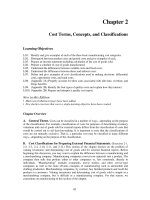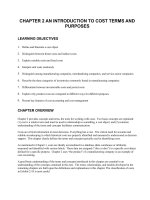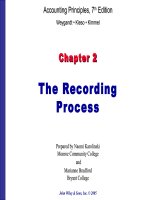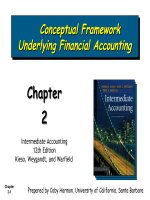Accounting 21th waren reeve fess chapter 02
Bạn đang xem bản rút gọn của tài liệu. Xem và tải ngay bản đầy đủ của tài liệu tại đây (2.82 MB, 85 trang )
Chapter 2
Analyzing Transactions
Accounting, 21st Edition
Warren Reeve Fess
PowerPoint Presentation by Douglas Cloud
Professor Emeritus of Accounting
Pepperdine University
© Copyright 2004 South-Western, a division
of Thomson Learning. All rights reserved.
Task Force Image Gallery clip art included in this
electronic presentation is used with the permission of
NVTech Inc.
Some
Some of
of the
the action
action has
has been
been automated,
automated, so
so
click
click the
the mouse
mouse when
when you
you see
see this
this
lightning
lightningbolt
bolt in
in the
the lower
lower right-hand
right-hand
corner
corner of
of the
the screen.
screen. You
You can
can point
point and
and
click
click anywhere
anywhere on
on the
the screen.
screen.
Objectives
Objectives
1. Explain why
accounts
are
used to record
After
studying
this
After
studying
this
and summarize
the
effects
of
transactions
chapter,
you
should
chapter, you should
on financial statements.
be
be able
able to:
to:
2. Describe the characteristics of an account.
3. List the rules of debit and credit and the
normal balances of accounts.
4. Analyze and summarize the financial
statement effects of transactions.
Objectives
Objectives
5. Prepare a trial balance and explain how
it can be used to discover errors.
6. Discover errors in recording
transactions and correct them.
7. Use horizontal analysis to compare
financial statements from different
periods.
Each
Each financial
financial statement
statement
item,
item, called
called an
an account,
account, isis
included
included in
in the
the ledger.
ledger.
A
A group
group of
of
accounts
accounts for
for aa
business
business entity
entity isis
called
called aa ledger.
ledger.
A
A list
list of
of the
the
accounts
accounts in
in aa ledger
ledger
isis called
called aa chart
chart of
of
accounts.
accounts.
Major Account Classifications
Assets
Assets are
are
resources
resources owned
owned
by
by the
the business.
business.
Liabilities
Liabilities are
are debts
debts
owed
owed to
to outsiders
outsiders
(creditors).
(creditors).
Cash
Supplies
Building
Accounts
receivable
Accounts
payable
Notes payable
Wages payable
Major Account Classifications
Liabilities
Liabilities are
are often
often identified
identified
on
the
balance
sheet
by
titles
on
the
balance
sheet
by
titles
Assets
are
Liabilities
are
debts
Assets are
Liabilities are debts
that
include
payable
.
that
include
payable
.
resources
owned
owed
to
outsiders
resources owned
owed to outsiders
by
(creditors).
by the
the business.
business.
(creditors).
Cash
Supplies
Building
Accounts
receivable
Accounts
payable
Notes payable
Wages payable
Major Account Classifications
Owner’s
Owner’s
equity
equity isisthe
the
owner’s
owner’s right
right to
to
the
the assets
assetsof
of the
the
business.
business.
Chris Clark,
Capital
Chris Clark,
Drawing
Revenues
Revenues are
are
increases
increasesin
in
owner’s
owner’s equity
equity as
as
aa result
result of
of selling
selling
services
servicesor
or
products.
products.
Fees Earned
Fares Earned
Commission
Revenue
Expenses
Expenses are
are the
the
using
using up
up of
of assets
assets
or
or consuming
consuming of
of
services
services to
to
generate
generate revenue.
revenue.
Rent Expense
Salary Expense
Utilities
Expense
To
To assist
assist you
you in
in learning,
learning,
an
an account
account can
can be
be drawn
drawn
to
to resemble
resemble the
the letter
letter T.
T.
The
The T-Account
T-Account
Cash
The
The T-account
T-account has
has aa title.
title.
The
The T-Account
T-Account
Cash
Left side
debit
The
The left
left side
side of
of the
the account
account isisthe
the debit
debit side.
side.
The
The T-Account
T-Account
Cash
Left side
debit
Right side
credit
The
The right
right side
side of
of the
the account
account isisthe
the credit
credit side.
side.
The
The T-Account
T-Account
Cash
3,750
4,300
2,900
Typical entries
850
1,400
700
2,900
Balancing
Balancing aa T-Account
T-Account
First,
First, foot
foot
the
the debit
debit
side.
side.
Cash
3,750
4,300
2,900
10,950
850
1,400
700
2,900
Cash
3,750
4,300
Next,
Next, foot
foot the
the
2,900
credit
credit side.
side.
10,950
850
1,400
700
2,900
5,850
Subtract
Subtract total
total credits
credits
Cash from
from total
total debits
debits to
to
obtain
the
account
obtain
the
account
3,750
850
balance.
balance.
5,100
4,300
2,900
10,950
1,400
700
2,900
5,850
Transactions and Balance
Sheet Accounts
(A) On
On November
November 1,
1, Chris
Chris Clark
Clark
(A)
deposits $25,000
$25,000 in
in aa bank
bank account
account
deposits
in the
the name
name of
of NetSolutions.
NetSolutions.
in
Page 1
JOURNAL
Date
Description
Ref.
2005
1 Nov. 1 Cash
2
3
4
Post.
Chris Clark, Capital
Invested cash in NetSolutions.
Debit
Credit
25 000 00
25 000 00
(A) On
On November
November 1,
1, Chris
Chris Clark
Clark
(A)
deposits $25,000
$25,000 in
in aa bank
bank account
account
deposits
in the
the name
name of
of NetSolutions.
NetSolutions.
in
Effects of this entry in the Ledger
Cash
Nov. 1
25,000
Chris Clark, Capital
Nov. 1
25,000
(B) On
On November
November 5,
5,
(B)
NetSolutions bought
bought land
land
NetSolutions
for $20,000,
$20,000, paying
paying cash.
cash.
for
4
5
6
5 Land
20 000 00
Cash
7
Purchased land for building
8
site.
9
10
20 000 00
(B) On
On November
November 5,
5,
(B)
NetSolutions bought
bought land
land
NetSolutions
for $20,000,
$20,000, paying
paying cash.
cash.
for
Effects of this entry in the Ledger
Cash
Nov. 1
25,000 Nov. 5
Land
20,000 Nov. 5
20,000
(C) On
On November
November 10,
10, NetSolutions
NetSolutions
(C)
purchased supplies
supplies on
on account
account
purchased
for $1,350.
$1,350.
for
10
11
12
13
14
15
16
10 Supplies
Accounts Payable
Purchased supplies on account.
1 350 00
1 350 00









